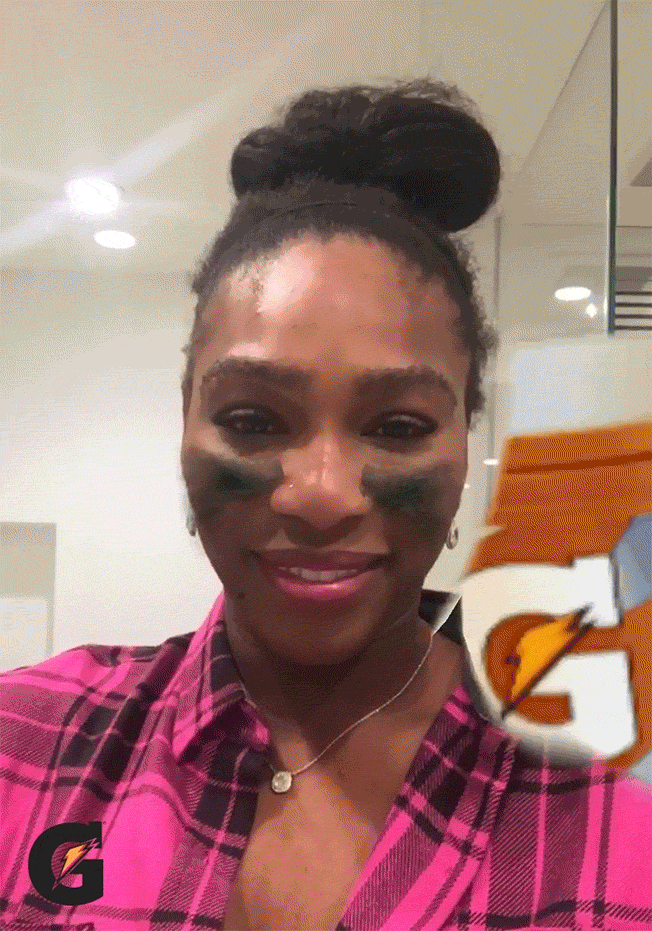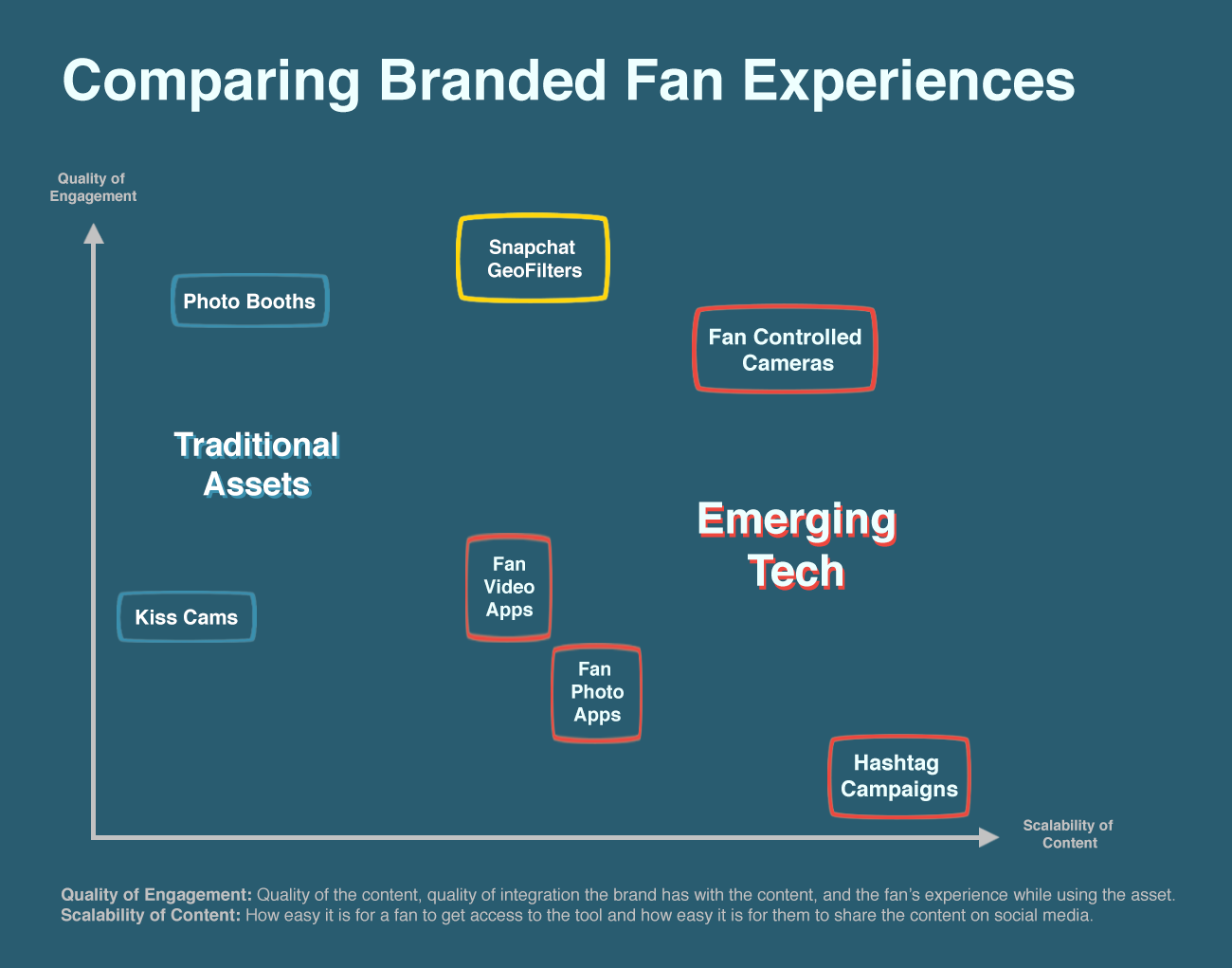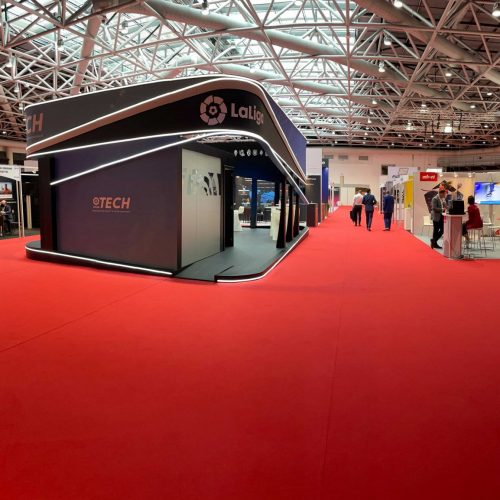The #1 Source of Unrealized Revenue by Sports Teams Today
This is a guest post by Stefan Kollenberg, Director of Engagement at Brizi, who create Fan-Controlled cameras that overlay authentic branding on user-generated content.
Great content has never been more valuable. Snapchat charges upwards of $10,000 for brands to run a geofilter over the TD Garden on game nights. At best, the Celtics can arrange a revenue share, or buy the rights themselves and re-sell it at a premium to sponsors. However, since Snapchat is the platform who ultimately owns this audience, sports teams are at the mercy of Snapchat cutting them out of the deal. That’s just one example of digital sponsorship ambush.
How can sports properties defend their rights to own and monetize fan generated content themselves? At SXSW this year, Dewayne Hankins (CMO, Portland Trail Blazers), Scott Carlis (SVP Digital Media, Learfield Sports), Kirsten Corio (Managing Director Ticket Sales & Digital Strategy, USTA) and Anna Hu (Co-Founder, Brizi) discussed in-depth the crowded sports media & sponsorship landscape, and on how properties can leverage technology to own and monetize fan generated content themselves.
Brands want experiences, not logos
Sport has always been a social activity. With non-stop access to social media, the stadium experience is full of people looking down at their phones when play stops. In fact, 75% of fans sharing content to social media during the game, instead of paying attention to the traditional signage brands are paying for in-stadium.
This has led to millions of photos being shared with the main benefactor, the social media platforms themselves, instead of the teams that generate the content.
These platforms feed off of the value of this content and take advantage of the traffic they are now able to monetize. This has forced sports teams to find other ways to monetize their social channels. Corio touched on this, saying “we need to do a better job of bringing [the] experience to life across social platforms. [Fans] already do it for us but how do we as the property owners do it in a way that’s more cohesive and monetized. This is our daily challenge.”
The team’s brand carries emotional value to consumers. However, if ambush-driven sponsors can associate with the team branding and target that fan base more effectively using Facebook, then teams are left out in the dust. To combat this, the fact is that digital can never replace real life experiences. Teams will always have a monopoly when it comes to in-stadium experiences, thousands of fans all cheering at the same time, those memories are considered sacred. As Carlis stated, “it’s all about the FOMO and YOLO moments, It’s about sharing those experiences, it’s about the ego. To be able to socialize that point of view and get different access points to it is what makes social and sports so synergistic and so symbiotic. From a brand perspective and from a media perspective that’s enormously important when developing these campaigns and solutions for monetization around sponsorships”.
Think about it like this, if a digital heatmap of the world was created based on “emotional energy” being generated, the spots on the map that would glow brightest are stadiums.
What partners want from their sponsorships
Associating with the emotional value in content has been used as a tactic for years, but with the advancements in user-generated content technology, it’s starting to re-shape the traditional sports sponsorship landscape. Carlis gave a great explanation as to why fan-created content strategies have been doing so well in sports: “partners want that touch, they want that deeper integration to move beyond the marks and the logos, they want to feel like they’re creating deeper emotional connections and if they can be the author of those deeper emotional connections around the community, well that’s the Holy Grail.”
When it comes to creating deeper emotional connections, this year at the Australian Open, 35,000 photos were taken by fans using the BriziCam and seen by their friends over 6.5 million times, which connected the sponsor to authentic and highly-emotional content. These fans acted as brand advocates, elevating brand affinity and brand trust when their friends are scrolling through Facebook and see the brand associated with their personalized photo.
Another great case study is the Gatorade Snapchat lense launched as part of their Super Bowl campaign. It received over 165 million views and rather than being an intrusive ad, their brand actually became part of the experience. This is a great example of the brand attaching itself to the ecstatic emotions of both winning the superbowl and the 33 year old Gatorade shower tradition.
Seven ways to monetize fan-created content
Fans sitting in stadiums, scrolling through their social media, are in fact being monetized by those platforms tracking this activity as quality impressions. Eyeballs are now on smartphones, not on stadium signage, and teams need to take notice. Below are a few tools that can help teams take ownership of fan content as property owners, in a way that’s more cohesive and monetized.
On-Site Photo Booths
Step in front of a green screen and get your high quality photos with branded overlays that can be shared to social media, fun props available to users.
Analysis: While quality of engagement is high for those users, it’s difficult to produce a large volume of photos due to the physical set-up and capacity limits. Assuming each user takes 90 seconds, in a 3 hour period, you can only have a maximum of 120 users with photo shares.
In-Stadium Kiss Cams
Camera operators find a few lucky fans in the crowd, streaming it to the big screen for everyone in the building to watch.
Analysis: Emotional energy is encapsulated in the few seconds each lucky fan gets on the big screen. However with only a 30-60 seconds of total screen time, opportunity is very limited. When considering content scalability, unless a clip is posted to social media and becomes viral, any substantial brand exposure ends within the walls of the arena.
Fan Controlled Cameras
Fans use their smartphone to remote-control a camera from their seats, finding themselves instantly, and capture the entire experience of being at the game in a high quality photo.
Analysis: Any fan can access this interactive experience during the game and share their photo instantly, automating both content production and distribution. The quality of engagement is also high because the entire experience is white-labelled for the brand, and the photo itself is professional grade.
Fan Video Apps
After the game finishes, fans can download an app to retrieve video clips from the big screen where they may have made an appearance.
Analysis: The video content retrieval process is fun and easily share-worthy for the lucky fans that got on the big screen. When looking at the scalability of content, only the lucky few can retrieve these videos and have to download an app to do so, most of the engagement occurs after the game for the footage to be processed, when momentum could have faded.
Fan Photo Apps
After the game finishes, fans can download an app to retrieve candid photos that were taken of them during the game.
Analysis: These photos capture exciting in-game moments for every fan in the arena, but the candid-nature of the photo reduces the quality of content fans may find, and this content may be less share-worthy. Similar to the video apps, it requires fans to wait until post-game to be able to share photos, and often the retrieval process is difficult to find themselves amidst the crowd.
Hashtag contests
Fans share photos to social media with a branded hashtag for a chance to get on the big screen or the team’s website.
Analysis: The opportunity to have their digital content transmitted to the big screen is appealing, though only few fans will get the exposure. From a sponsorship standpoint there is no branding attached on any of the photos except by willful association. Overall this leads to easy access for fans, but very low quality engagement for brand sponsors.
Snapchat GeoFilters
Fans with the Snapchat app can engage with a branded filter on their selfie, sharing it with their immediate friend group.
Analysis: Snapchat is known to be highly engaging, but the content created is intentionally limited to an internal group of Snapchat friends, making it difficult to scale the content distribution.
Remember to base your digital strategy on content scalability, value to fans, value to partners, data collection capabilities, and ease of use. all of which will be discussed in the upcoming e-book “How to Maximize Your Digital Sponsorship Assets”.
About author
You might also like
SPORTEL 2021: Day One Recap
This year’s prestigious SPORTEL convention kicked off in sunny Monaco today, welcoming a host of familiar faces as well as plenty of new ones. Doors opened at 8:30am with businesses
Six Founding Riders Set To Bring The Vision Of The UCI Track Champions League To Life
Olympic Champions, UCI World Champions and World Record holders join the new track cycling competition debuting in November 2021 The UCI Track Champions League is delighted to announce that six
Sports related spending to soar this summer as pre-pandemic life resumes
New insights from eBay Ads UK reveal the potential for brands to engage with an excited but nervous nation as sports events get back on track As pubs and indoor










